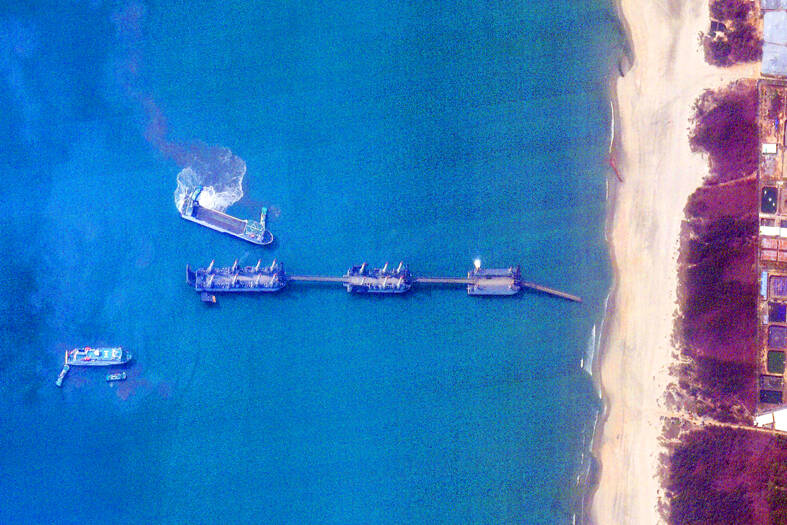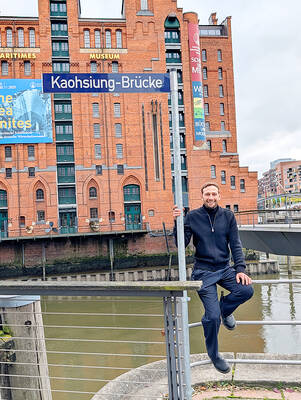Vast new Chinese barges spotted off the country’s south coast could be used to land heavy equipment and thousands of personnel in a possible invasion of Taiwan, defense experts say.
Beijing this week launched what it called “punishing” drills around Taiwan, sending jets and warships in a rehearsal for a blockade and assault on the nation.
A memo from US Naval War College has revealed another potential weapon in Beijing’s arsenal: barges that could connect via extendable ramps to form an 820m pier from deep waters to land.

Photo: Planet Labs PBC, AFP
With retractable legs that can push into the sea floor, they could create a platform for personnel and “hundreds of vehicles” to land on Taiwan in one hour, the Naval War College said.
“These barges are clearly meant to facilitate amphibious invasion against Taiwan,” said Sung Wen-ti (宋文笛), a nonresident fellow at the Atlantic Council’s Global China Hub.
Wargaming of a potential Chinese invasion of Taiwan long assumed that the Chinese People’s Liberation Army (PLA) would have been forced to rely on small amphibious landing vessels to get ashore.
Only a handful of Taiwan’s beaches are suitable for large-scale amphibious landings, giving Taipei a critical edge in its defense.
“These barges may enable Chinese forces to make landings even on the more challenging terrains of the Taiwanese coastline,” Sung said.
That “gives the Chinese military a greater selection of potential landing spots, and spreads Taiwanese defenses thin,” he said.
Satellite images from Planet Labs PBC show the system deployed in the waters off Zhanjiang city in China’s southern Guangdong Province at the end of last month.
In a program on state TV last month discussing the barges, military commentator Wei Dongxu touted their ability to transport large numbers of heavy equipment onto an island “while keeping their feet dry.”
“Once the naval and air forces effectively control the air and sea, then this ... barge will appear,” he said. “It can be said that it is a sign of victory.”
Another three barges, dubbed Shuiqiao (水橋, “water bridge”) by analysts, are under construction in southern China, the US Naval War College said.
“They embody the seriousness with which China under [Chinese] President Xi Jinping [習近平] is pursuing absorption of Taiwan by any means possible,” US Naval War College China Maritime Studies Institute professor Andrew Erickson said. “China ... would not waste resources on such a specialized, dedicated system if it were not bore-sighted on taking Taiwan by threat, or use, of force.”
China could harness its world-leading shipbuilding industry to rapidly build many more barges at an affordable cost, Erickson said.
Beijing has ramped up military pressure on Taipei in recent years and held multiple large-scale exercises around the nation, which are often described as rehearsals for a blockade and seizure of Taiwan.
During this week’s drills, the Ministry of National Defense said it had detected 21 warships, 71 aircraft and four coast guard vessels around the nation on Tuesday.
China’s Shandong aircraft carrier also took part in the drills.
The drills, held less than a month after President William Lai (賴清德) called China a “foreign hostile force,” saw Beijing practice striking “key energy sites” and ports, Beijing’s military said.
Despite the bravado from Beijing, defeating well-prepared Taiwanese defenders and performing a successful invasion still poses major challenges to China’s modernizing military.
The barges are still no panacea for the logistical woes that are to plague any future invasion.
The barges “appear vulnerable to attacks from land, air and sea,” the US Naval War College said.
“There are reasons why these capabilities aren’t commonly touted as particularly viable,” Asia Society Policy Institute managing director Rorry Daniels said.
“They’re ... hard to hide, hard to defend, slow to move,” Daniels said. “You need air superiority for them to work and it’s not clear to me that Beijing could establish air superiority over Taiwan.”
Erickson said they “cannot hope to survive in isolation.”
Although still appearing to be in a trial phase of their deployment, the barges could be aimed at sending a message to Taiwan’s leaders.
“Beijing is saying: ‘We are actively problem-solving the issues that we see with a full-scale invasion of Taiwan,’” Daniels said. “‘And you should be worried about that.’”

TRAFFIC SAFETY RULES: A positive result in a drug test would result in a two-year license suspension for the driver and vehicle, and a fine of up to NT$180,000 The Ministry of Transportation and Communications is to authorize police to conduct roadside saliva tests by the end of the year to deter people from driving while under the influence of narcotics, it said yesterday. The ministry last month unveiled a draft of amended regulations governing traffic safety rules and penalties, which included provisions empowering police to conduct mandatory saliva tests on drivers. While currently rules authorize police to use oral fluid testing kits for signs of drug use, they do not establish penalties for noncompliance or operating procedures for officers to follow, the ministry said. The proposed changes to the regulations require

The Executive Yuan yesterday announced that registration for a one-time universal NT$10,000 cash handout to help people in Taiwan survive US tariffs and inflation would start on Nov. 5, with payouts available as early as Nov. 12. Who is eligible for the handout? Registered Taiwanese nationals are eligible, including those born in Taiwan before April 30 next year with a birth certificate. Non-registered nationals with residence permits, foreign permanent residents and foreign spouses of Taiwanese citizens with residence permits also qualify for the handouts. For people who meet the eligibility requirements, but passed away between yesterday and April 30 next year, surviving family members

Taiwanese officials are courting podcasters and influencers aligned with US President Donald Trump as they grow more worried the US leader could undermine Taiwanese interests in talks with China, people familiar with the matter said. Trump has said Taiwan would likely be on the agenda when he is expected to meet Chinese President Xi Jinping (習近平) next week in a bid to resolve persistent trade tensions. China has asked the White House to officially declare it “opposes” Taiwanese independence, Bloomberg reported last month, a concession that would mark a major diplomatic win for Beijing. President William Lai (賴清德) and his top officials

The German city of Hamburg on Oct. 14 named a bridge “Kaohsiung-Brucke” after the Taiwanese city of Kaohsiung. The footbridge, formerly known as F566, is to the east of the Speicherstadt, the world’s largest warehouse district, and connects the Dar-es-Salaam-Platz to the Brooktorpromenade near the Port of Hamburg on the Elbe River. Timo Fischer, a Free Democratic Party member of the Hamburg-Mitte District Assembly, in May last year proposed the name change with support from members of the Social Democratic Party and the Christian Democratic Union. Kaohsiung and Hamburg in 1999 inked a sister city agreement, but despite more than a quarter-century of